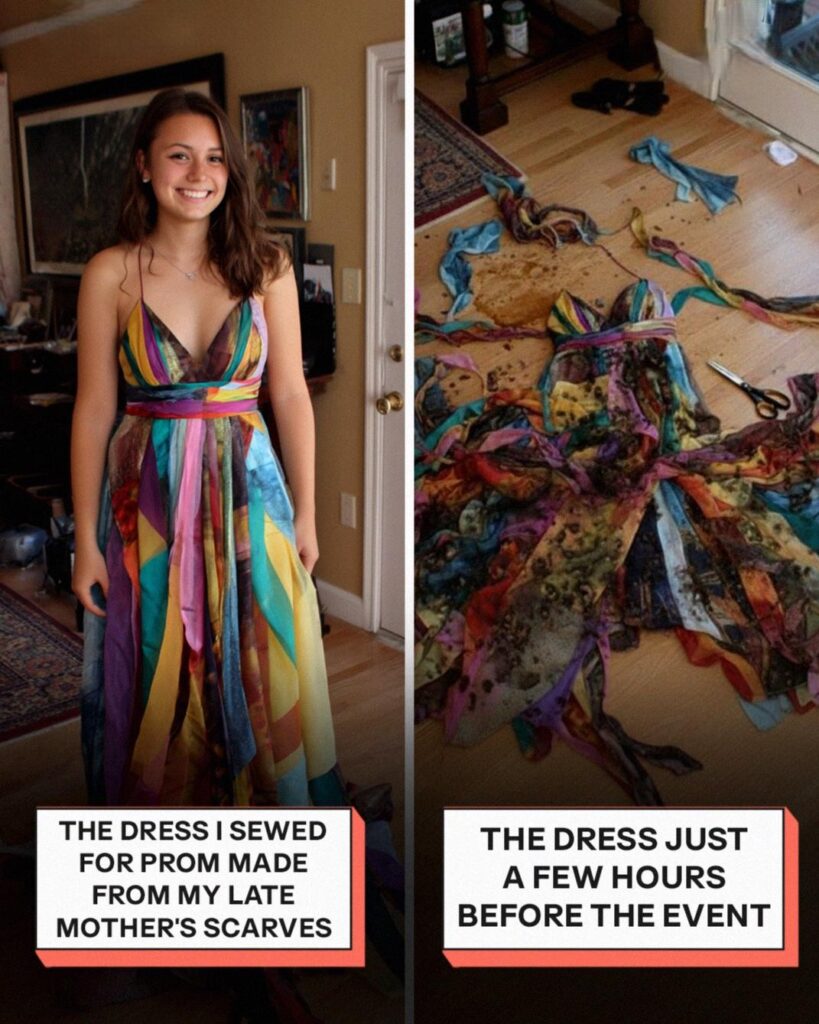I never expected justice to arrive wrapped in silence, nor did I anticipate that the loudest sound in my life would be the quiet click of a front door closing forever. My name is Emma, and at seventeen, I had become an expert in making myself small. In the suburbs of Michigan, where the days drifted by in a haze of high school football games and changing seasons, I had learned that invisibility was the safest armor. But it wasn’t always this way. My world was once a kaleidoscope of color, anchored by a woman who didn’t just walk into a room—she illuminated it.

My mother, Sarah, was a force of nature composed of soft edges and radiant laughter. She battled cancer for two years with a quiet, steady grace that I still struggle to comprehend. Through the chemo and the fading energy, she never lost her sense of self, a trait best exemplified by her collection of scarves. They were her signature. She had them in every conceivable texture and hue: heavy knits for the biting winter, gossamer silks for spring, bold geometric prints, and soft, earthy cottons. “Scarves are like moods, Emma,” she would tell me, wrapping a mint-green silk around her thinning hair. “You don’t just wear them to cover up; you wear them to remind the world you’re still here.”
When she passed, the silence in our house was deafening. Her scarves were packed away in a floral box smelling of jasmine and vanilla, placed high on a shelf in my closet—a shrine I visited only when the grief felt too heavy to carry alone. My father, a good man paralyzed by loss, retreated into his work. He became a ghost in his own home, heating up frozen dinners and offering vague, distracted smiles. We were two ships drifting in a sea of gray, until three years later, when Valerie boarded.
Valerie was everything my mother was not. Where Mom was vibrant and cluttered with life, Valerie was beige, minimalist, and clinically organized. She worked in finance at Dad’s company and moved into our lives with the efficiency of a corporate merger. She wasn’t outwardly cruel at first; she was simply cold, like a drafty window you can’t quite close. Slowly, traces of my mother began to vanish. A chipped mug disappeared. A framed photo on the mantel was replaced by abstract art. “We need to focus on the future, Emma,” she would say with a tight, thin smile. “Living in the past is messy.”
By my senior year, the erasure felt almost complete. Prom was approaching, and while my friends obsessed over sequins and designer labels, I felt a pull toward something different. I didn’t want a dress off a rack; I wanted to feel close to the one person who wouldn’t be there to see me off. The idea came to me on a Tuesday night, sitting with the floral box in my lap. I would make a dress out of Mom’s scarves.
For two weeks, I sewed in secret. I wasn’t a professional seamstress, but I poured every ounce of love I had into that fabric. I used the yellow cotton she wore to church, the turquoise silk from my twelfth birthday, and the deep red wrap Dad had given her during their last Christmas. Cutting into them felt like a holy act, a transformation of grief into joy. The result was a patchwork of memories—a flowing, bohemian gown that shimmered with history. It wasn’t perfect; the hem was slightly uneven, and the stitching was visible, but it was alive. It was her.
On the morning of prom, I woke up with a lightness I hadn’t felt in years. I curled my hair, pinned it back with pearls, and opened my closet door, ready to step into my masterpiece.
My breath hitched, then stopped entirely. The dress was gone.
In its place, a pile of shredded fabric lay on the floor. The silk was slashed, the cotton torn, the vibrant colors reduced to a heap of confetti. I dropped to my knees, my hands trembling as I tried to scoop up the ruins, as if I could hold the pieces together by sheer will.
“You’re welcome.”
The voice came from the doorway. Valerie stood there, dressed for work, sipping coffee from a pristine white mug. She looked at the devastation on my floor with the satisfaction of someone who had finally cleaned a stubborn stain.
“What… what did you do?” I choked out, tears blurring my vision.
“I saved you from humiliating yourself,” she said calmly, taking a sip. “Those rags should have been thrown out years ago. Do you really think your mother would want you parading around looking like a beggar? It was embarrassing, Emma.”
I couldn’t breathe. The cruelty was so casual, so mundane. I clutched the red silk to my chest and wept.
Then, the floorboards creaked. My father appeared in the hallway, buttoning his shirt, phone in hand. He froze. His eyes darted from my sobbing form on the floor to the mutilated fabric, and finally to Valerie’s smug expression. For the first time in years, the fog that seemed to surround him evaporated.
“What is going on?” His voice was low, a rumble of awakening thunder.
“I just threw out that ridiculous thing she made,” Valerie sighed, checking her watch. “Honestly, you should thank me—”
“You did what?” Dad’s voice cracked, rising into a shout that shook the walls.
Valerie flinched, stepping back. “I… I just thought…”
“Those were Sarah’s,” he roared, stepping into the room. He looked down at the yellow fabric—the one she wore on Sundays—now ripped in two. The sight broke him. “Do you have any idea what those meant? To her? To us?”
“I was trying to help!” Valerie stammered, her composure cracking.
“No,” Dad said, his voice dropping to a terrifyingly icy calm. “You were trying to erase her. And I let you do it for too long. Get out.”
“Excuse me?”
“Pack your bags, Valerie. I want you gone. Now.”
She stared at him, waiting for the retraction, for the apology. It never came. Dad turned his back on her and knelt beside me. He wrapped his arms around me, burying his face in my hair, sobbing. “I’m so sorry, Emma. I’m so, so sorry.”
Valerie left an hour later. I didn’t watch her go. I gathered the scraps of my dress and drove to school, my eyes swollen, seeking the only sanctuary I had left: the art room. Mrs. Henderson, the textiles teacher, didn’t ask questions. She took one look at the fabric and pulled up a chair. “We can save this,” she said firmly.
We worked for hours. We couldn’t hide the tears in the fabric, so we didn’t try. We highlighted them. We used gold thread to stitch the pieces back together, reinforcing the rips, turning the damage into a design. It was a technique called kintsugi—making the broken beautiful. The dress that emerged was different than the one I had planned. It was textured, complex, and undeniably resilient.
When I walked downstairs that evening, the house was quiet. The beige art was gone. The air felt lighter. Dad was waiting by the door with his camera. When he saw me—wearing the mosaic of my mother’s life, held together by gold thread and determination—he wept openly.
“You look just like her,” he whispered.
Prom was a blur of lights and music, but the real magic happened when I returned home. The driveway was empty of Valerie’s car. The house was dark, save for the porch light guiding me in. Inside, it didn’t feel empty; it felt cleansed.
Dad was sitting in the living room, looking at an old photo album he hadn’t touched in five years. He looked up as I entered, a genuine smile touching his eyes. We didn’t need to say much. The toxic presence was gone, and in its wake, we had found each other again.
I hung the dress back in my closet, the moonlight catching the gold stitching. It wasn’t the dress I had started with, and we weren’t the family we had been before Mom died. We were stitched back together, scarred and imperfect, but finally, we were whole.
